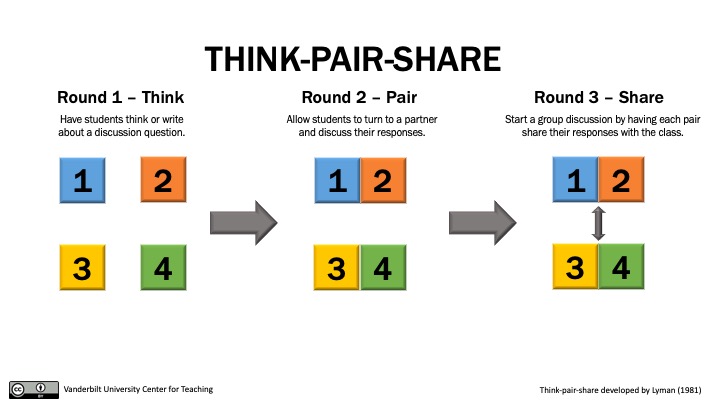 As the semester starts and progresses, it’s often best to employ engagement strategies to hold student interest and aid in their success. Here are a few ideas to try to engage students.
As the semester starts and progresses, it’s often best to employ engagement strategies to hold student interest and aid in their success. Here are a few ideas to try to engage students.
Ideas for a Face-to-Face Class
Use Icebreakers
Icebreakers are often used as a way to get people to know one another and introduce them to new knowledge. They’re best used at the start of a course during the start of the semester but can also be used during the academic semester.
For examples and ideas of icebreakers please take a look at the CTL’s post on Icebreakers.
Tell a Story
Telling a story communicates information in a way different than standard teaching. Turning the background of content, such as a historical event or scientific discovery, can captivate students and keep them interested in the class content that is to occur. For more information on telling a story in the classroom.
For more information please take a look at the UC Berkeley Center for Teaching & Learning article, “Are You Telling Stories in the Classroom?“.
Get Active
One of the best ways to engage students is to have them do something that engages them within their own learning. This typically revolves around creating activities, such as lab work, simulations, peer instruction, and more. Engaging students in active learning can even replace aspects of lecture content, helping to move students from being passive learners to active ones.
For more information on active learning please take a look at Vanderbilt University Center for Teaching’s page on Active Learning.
Collaborate!

Along with active learning there are multiple collaborative learning strategies. Many of the these strategies can help students learn content and convey it to the rest of the class, encompassing both passive and active ways of gaining knowledge. For example, consider a strategy like think-pair-share to help students become engaged with the content and with each other.
For some quick ideas on collaborative strategies please take a look at the CTL’s post on Student Collaboration in the Face-to-Face Classroom.
Ideas for an Online Class
Communicate Clear Expectations
As online courses lack direct contact, it’s necessary to inform students of class expectations. Students need to be aware of how to communicate with the instructor and each other, as well as standards for logging into the class, interacting with the class, and completing tasks.
Provide a Variety of Content
Online courses are commonly filled with a great amount of text to review. Giving students alternative types of content can help engage students, while simultaneously giving the instructor to have a different way of expressing important content. Consider deploying video (both pre-made and self-made) incorporating images, audio, infographics, and interactive tools.
Offer Collaborative Opportunities
Online courses can offer collaborative opportunities that are different from a face-to-face course and go beyond a discussion board. For example, students can engage in social media conversations or in-class debates. They can also make use of unique tools like Anchor for a podcast.
For some quick ideas on collaborative strategies online please take a look at the CTL’s post on Student Collaboration in the Online Classroom.
Provide Different Ways of Completing Assignments
Online classes do not have to be limited to text-based responses for class assignments. Most systems, including Canvas, allow for students to respond in a variety of methods. Consider allowing student responses for tasks to be in the form of video, simulations, or a collaborative activity. For example, have students respond to a discussion board question through video, allowing each student to respond to one another with a video of their own. Also, consider offering assessments that go beyond text or multiple choice by using alternative assessments.
Technology for Engagement
Some technology tools can also be used to help engage students. Here are a few examples to start.
Use Video
Video is a great way to engage students. Video can be created by the instructor or sourced from another location such as YouTube. It’s possible to record video directly into Canvas for both student and instructor, allowing for video discussion and media assignments to take the place of textual tasks. Instructors can also make use of the Panopto video management system to record and store video without opening it to the public web. A tool like Flipgrid can also be deployed for student to student video interaction with intentional time limits and other media features.
For more information on recording video directly into Canvas please read the guide, “How do I record a video using the Rich Content Editor as an instructor?” (note: the process is the same for students).
For more information on Panopto within Canvas please take a look at the CTL’s post on Using Panopto in Canvas – Important First Steps.
For more information on Flipgrid please see the Flipgrid website.
Canvas Groups
Canvas can aid an instructor in creating collaborative groups for class tasks, both face-to-face and online. Students can then work on tasks together, submitting them for a group or individual grade. They’re also a great way of focusing discussions on small groups rather than the whole class.
For more information on Groups in Canvas please refer to the Canvas guides about Groups.
Canvas Discussions
Canvas Discussions are often used within an online class as a point of student to student contact, but can also be used within a face-to-face course to encourage interaction both before and after a class session. Canvas Discussions can also be used as the focal point of a debate activity, whereby students can work to discuss opposing viewpoints. They are also great as the host of video based discussions as each reply can leverage the typical Canvas text editor with its video capabilities.
For more information about Canvas Discussions please refer to the Canvas guides about Discussions.
Use or Create Infographics

Infographics are a great way to express content in a visual manner, helping to drill to the salient points of a topic in a design that often can resemble a flow chart. Infographics are commonly used online in multiple mediums, such as the college’s Fast Facts Fall 2018 flyer. Infographics can be created through tools like Canva, a visual design tool with easy to use features.
Have Your Own Ideas? Please Share!
Do you have your own engagement ideas? Please share them with us through our contact form!
Questions? We can help!
Have questions about instruction, course design, teaching methods, technology to help, or more? Please contact the Center for Teaching & Learning through our contact form or by phone at (708) 974-5347.
